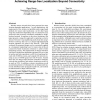Free Online Productivity Tools
i2Speak
i2Symbol
i2OCR
iTex2Img
iWeb2Print
iWeb2Shot
i2Type
iPdf2Split
iPdf2Merge
i2Bopomofo
i2Arabic
i2Style
i2Image
i2PDF
iLatex2Rtf
Sci2ools
104
click to vote
SENSYS
2009
ACM
2009
ACM
Achieving range-free localization beyond connectivity
Wireless sensor networks have been proposed for many location-dependent applications. In such applications, the requirement of low system cost prohibits many range-based methods for sensor node localization; on the other hand, range-free localization depending only on connectivity may underutilize the proximity information embedded in neighborhood sensing. In response to the above limitations, this paper presents a range-free approach to capturing a relative distance between 1-hop neighboring nodes from their neighborhood orderings that serve as unique high-dimensional location signatures for nodes in the network. With little overhead, the proposed design can be conveniently applied as a transparent supporting layer for many state-of-the-art connectivity-based localization solutions to achieve better positioning accuracy. We implemented our design with three well-known localization algorithms and tested it in two types of outdoor test-bed experiments: an 850-foot-long linear network w...
Range-free Localization | Sensor Networks | Sensor Node Localization | SENSYS 2009 | Wireless Sensor Networks |
| Added | 19 May 2010 |
| Updated | 19 May 2010 |
| Type | Conference |
| Year | 2009 |
| Where | SENSYS |
| Authors | Ziguo Zhong, Tian He |
Comments (0)

